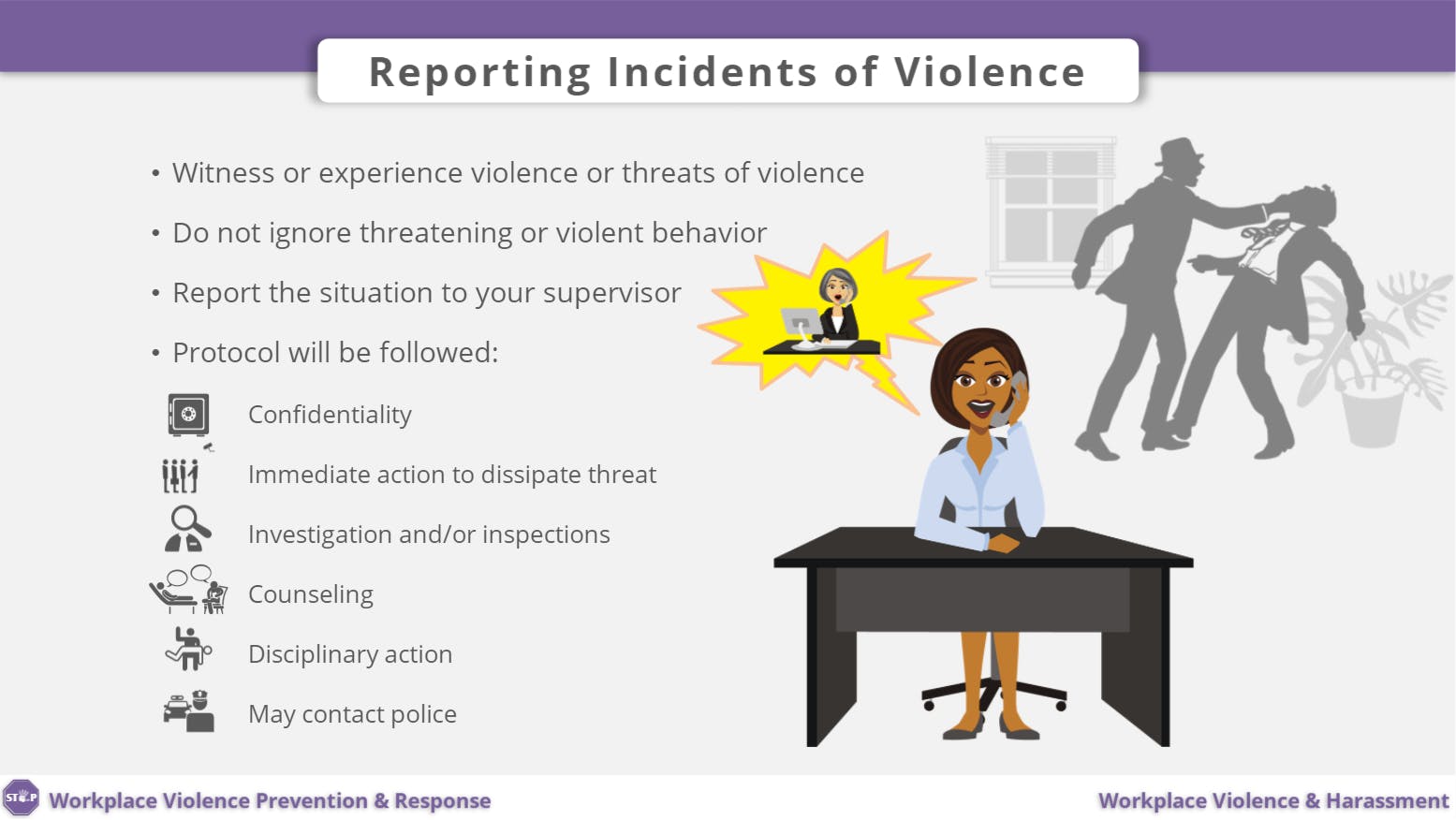Exactly how to Create a Durable California Workplace Violence Prevention Plan for Your Company
Exactly how to Create a Durable California Workplace Violence Prevention Plan for Your Company
Blog Article
The Function of Worker Training and Understanding in Enhancing Work Environment Physical Violence Avoidance Initiatives Throughout Numerous Industries
The assimilation of staff member training and recognition right into work environment violence prevention initiatives is increasingly identified as a basic facet of business safety across diverse sectors. By applying targeted training programs, organizations can effectively encourage their labor force to determine and deal with prospective risks before they rise. The efficiency of these initiatives often pivots on a number of crucial factors that differ by market, raising important inquiries regarding the versatility of training techniques and their real-world impact. Understanding these nuances may reveal methods that can considerably boost safety methods and employee self-confidence in high-risk environments.
Importance of Educating Programs
In today's vibrant work setting, the importance of training programs can not be overemphasized, particularly in the context of workplace physical violence avoidance. These programs function as a foundational element in growing a safe and secure and secure workplace culture. By furnishing employees with the expertise and skills required to determine, reduce, and react to potential risks, companies can cultivate a setting that focuses on security and health.
Effective training programs do even more than simply instruct; they equip employees to identify warning signs of physical violence, recognize the methods for reporting cases, and develop strategies to de-escalate possible problems. They infuse a feeling of collective obligation amongst team, encouraging positive involvement in keeping a risk-free office.
Financial investment in training not just improves staff member recognition however likewise shows a company's dedication to safeguarding its labor force. This proactive strategy can cause lowered occurrences of office physical violence, lower absence, and enhanced worker spirits. Inevitably, thorough training programs are integral to establishing a resilient organizational culture that values security and advertises a healthy and balanced workplace, therefore lowering the danger of physical violence and its connected consequences.
Key Parts of Effective Recognition
A detailed recognition program encompasses a number of crucial parts that are crucial for efficiently protecting against workplace physical violence. Clear communication of policies and procedures associated to workplace violence is critical. Staff members should be educated regarding the organization's stance on violence and the details protocols in place for reporting incidents.
Second, training sessions must incorporate realistic scenarios that staff members might encounter. This practical method assists employees acknowledge alerting indicators of potential physical violence and outfits them with the needed abilities to de-escalate tense scenarios. Third, fostering a supportive office society is crucial; staff members need to feel encouraged to speak out without concern of revenge.
Furthermore, continuous education is very important to keep recognition fresh and relevant. Regular correspondence course and updates on emerging risks can improve employees' alertness and readiness. Including comments devices allows staff members to share their experiences and understandings, which can lead to constant improvement of awareness initiatives. By incorporating these components, organizations can produce a robust structure for preventing office physical violence, inevitably adding to a much safer and much more effective atmosphere for all workers.
Industry-Specific Training Approaches
Effective work environment violence avoidance training have to be tailored to the one-of-a-kind obstacles and dangers encountered by specific industries. For example, medical care atmospheres require training that attends to the high chance of experiences with aggressive individuals or visitors. Programs should focus on de-escalation methods, acknowledging indication of possible violence, and guaranteeing staff recognize the value of reporting occurrences.
In contrast, retail settings may encounter various threats, such as burglary or client disagreements. Training in these environments need to stress situational awareness, feedback procedures during emergency situations, and the significance of safeguarding cash and valuables.
Production and construction markets present their very own threats, frequently linked with interpersonal conflicts or hazardous working conditions. Training in these markets should consist of strategies for dispute resolution, advertising a society of safety and security, and motivating open communication amongst staff members.
Additionally, company offices might need training centered on stopping harassment and bullying, cultivating a considerate office culture, and applying clear coverage mechanisms. Each sector has to not only recognize its particular vulnerabilities however additionally adapt training materials to reverberate with the workforce efficiently, making sure that employees really feel complete and empowered to handle prospective terrible scenarios.
Gauging Educating Efficiency
Examining the impact of work environment violence prevention training is essential for making certain that workers are sufficiently prepared to deal with prospective risks. To accurately measure training effectiveness, organizations should carry out both qualitative and measurable analysis techniques. Pre- and post-training studies can evaluate changes in staff member knowledge, attitudes, and behaviors concerning workplace violence. These studies must concentrate on certain training goals to make certain placement with the organization's objectives.
Additionally, useful assessments, such as role-playing situations or simulations, can provide insights right into just how well staff members use discovered skills in real-life circumstances. Checking occurrence reports prior to and after training can also offer as an indication of efficiency, as a reduction in cases may show enhanced worker readiness.
In addition, feedback from participants should be systematically gathered to determine areas for enhancement in training material and shipment. Carrying out follow-up examinations at routine periods aids find out receive recognition and reinforces training principles over time - california workplace violence prevention. By employing an extensive technique to gauging training performance, organizations can guarantee that their work environment physical violence avoidance campaigns cultivate a more secure atmosphere and improve total worker wellness
Building a Culture of Safety

Educating plays a pivotal role in this social shift. Regular, detailed training sessions inform staff their explanation members concerning recognizing indication of work environment physical violence and the ideal actions. Furthermore, urging open communication permits workers to voice concerns without concern of retaliation, advertising collective obligation for safety and security.
In addition, incorporating safety into day-to-day procedures guarantees that it becomes a shared worth as opposed to a mere compliance problem. This consists of normal safety and security drills, updates on policies, and feedback systems that include staff members in safety and security discussions and improvements.
Eventually, a durable society of safety and security not just minimizes the threats of workplace violence but likewise improves worker morale and efficiency. By promoting an atmosphere where security is an essential top priority, companies can develop resistant offices that sustain both specific health and cumulative success.
Final Thought
In final thought, worker training and understanding are crucial elements in the prevention of work environment violence across various industries. Effective training programs, tailored to certain market requirements, improve staff members' capacity to identify and respond to possible threats. By executing thorough awareness use this link strategies and fostering a culture of safety, organizations can substantially lower incidents of office physical violence and enhance overall employee spirits. Dedication to continuous training and assessment ensures continual efficiency and versatility in dealing with arising challenges within the office atmosphere.

Routine, thorough training sessions educate employees regarding acknowledging caution indicators of office violence and the suitable actions.In verdict, employee training and recognition are important parts in the avoidance of workplace violence throughout numerous sectors.
Report this page